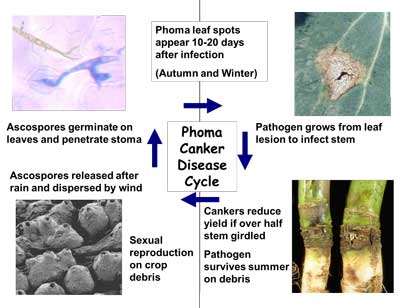- Phoma banner
- Phoma leaf spot Jon West
- Phoma leaf spot Jon West
- Lmaculans pseudothecia on debris Rothamsted Research
- Early mid stage stem canker Jon West
Appearance, Biology and Impact
Phoma stem canker is caused by two closely related fungal plant pathogens, Plenodomus lingam and P. biglobosus (formerly Leptosphaeria maculans and L. biglobosa). P. lingam is considered to be more aggressive generally but there are indications that P. biglobosus can also be damaging on some varieties as the resistance genes against one pathogen may not be effective against the other. The asexual stage of P. lingam is Phoma lingam.
It is a problem in the southern half of the UK (AHDB East-West oilseed rape growing regions).

The disease cycle is similar for both pathogens, which survive over summer on crop debris, particularly the taproot and stem bases of old oilseed rape stubble, which become encrusted with black fruiting bodies. Most fruiting bodies are initially the asexual structures that release rain-splash dispersed spores (conidia) but by late summer and into the autumn, the sexual stage occurs as small black spheres around 0.5 mm in diameter. These mature to release wind dispersed spores (ascospores) after rain or wetting by dew. The ascospores can blow long distances but most are deposited within 300 m of the source. Ascospores deposited on leaves of new crops germinate in moist conditions and infect leaves via stomata and wounds, leading to small pale lesions (phoma leaf spot) that appear 7-15 days after infection depending on temperature. The pale lesions develop black specks, which are additional asexual fruiting bodies that release splash-dispersed spores. Lesions of L. biglobosa are usually smaller and darker in appearance but both types vary according to interactions with the cultivar and recent weather. From phoma leaf spot lesions, the fungus grows symptomlessly through the leaf to the stem, where it incubates until early spring when rapid growth by the fungus produces a visible stem rot or canker. Severe cankers cause early senescence and lodging but in UK conditions, cankers do not reduce yield unless they expand to girdle at least half the stem by late May.
Control Options
Plant breeders have improved resistance of oilseed rape to phoma stem canker in the past 30 years. Currently no varieties are completely resistant to the disease but some varieties escape many infections due to resistance genes that prevent some spores from infecting and a good background level of quantitative or partial resistance also reduces the severity of disease where infections occur. In 2022, commercially available varieties have resistance ratings of 4 to 9 (pages 29 & 30 of the AHDB recommended list: AHDB Recommended Lists for cereals and oilseeds 2022-23 (first edition). Although two varieties are rated as 9 (fully resistant to the disease), one of those, ‘Crossfit’ is a hybrid type that is only recommended for use on clubroot-affected land. The other is a hybrid type called ‘Tennyson’, which is recommended only for the East-West region of the UK. Six other varieties have a score of 8 and ten have a score of 7, so most current varieties are resistant or moderately resistant. This is due to recent success in resistance breeding against P. lingam, although not necessarily improving resistance to P. biglobosus.
Cold weather slows down disease development resulting in reduced canker severity by harvest and a delay in release of ascospores the following autumn. This is why the disease is generally not a problem north of Lincolnshire. The knock-on effect of cold winters and improved cultivar resistance had reduced the impact of canker nationally until 2018. However, it remains a threat in the south, particularly if climate change predictions come true and it is advised that at least one autumn fungicide increases yields, partially due to control of canker by preventing early infection of the stem. Fungicides have very little effect once the fungus has reached the stem, indeed, the best timing of fungicide application is after the first significant release of ascospores in the autumn, ideally before more than 10-20% of plants have phoma leaf spots. The timing of spore release varies each year due to the weather with wet summers promoting an early release (10% plants with phoma leaf spots by late September). A weather-based forecasting tool is available, which forecasts the date when 10% of plants will have phoma leaf spot: Phoma leaf spot forecast | AHDB. It is advised that on susceptible varieties a two-spray autumn fungicide regime is best if phoma leaf spotting occurs early in the autumn (before mid-October), while a single autumn spray is effective if phoma leaf spotting is late (appearing after mid-October). On more resistant varieties, fungicide applications can be reduced or omitted completely (against Phoma stem canker) if phoma leaf spotting is late. An autumn fungicide may still be needed against other diseases such as light leaf spot. Information on fungicide efficacy is available from the AHDB – see: page 35 onwards in this link (which includes OSR despite the name) Barley